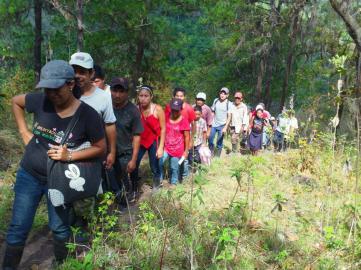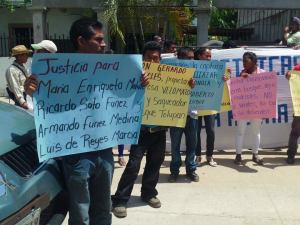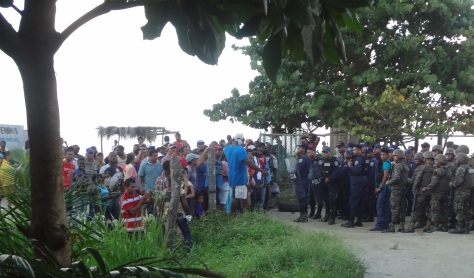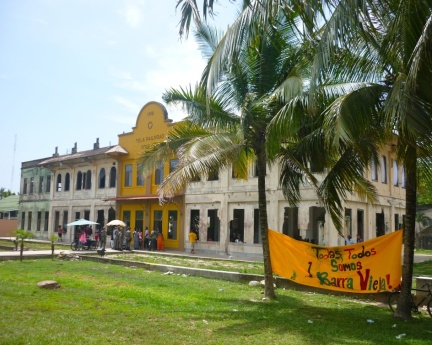On April 11, 2015, PROAH accompanied an activity organized by the Preventative Council of the Tolupán Tribe of San Francisco de Locomapa and MADJ (Broad Movement for Dignity and Justice), which included a walk along one of the tribal boundary lines in recognition of their lands.
The activity included a homage for Luis de Reyes Marcía, Tolupán indigenous member of the community of Locomapa, Yoro, who was assassinated on April 4, 2015. Luis is the fourth land rights defender murdered in this small community, following the murder of three of his companions in the land struggle, in 2013.
Two years after the murders of three Tolupán land rights defenders in 2013, these crimes remain in impunity:
On August 25, 2013 three indigenous Tolupán were murdered by gunfire in the community of Locomapa, Yoro, in northern Honduras. The victims were María Enriqueta Matute, Armando Fúnez Medina, and Ricardo Soto Fúnez. They, along with other members of the Tribe of San Francisco de Locomapa, were organizing to protect natural resources and to oppose the illegal mining of antimony and logging on their communal lands. The murders occurred after 12 days of protest by the community, peacefully blocking the road. Witnesses testify that the murders were committed by two men belonging to a group that works for the mine and powerful business interests in the region. (see PROAH article 2013).
In response to a petition for protection for the community issued by MADJ, in December 2013 the Inter American Human Rights Commission (IACHR) issued protective measures for 18 members of the community and their families, a total of 38 people. On February 22, 2014, in a public ceremony, which PROAH team members attended as international observers, Honduran authorities committed to fulfill their obligation to protect those under threat and to capture the suspected assassins.
However, the State of Honduras has not fulfilled its obligation to implement protective measures. The situation of impunity and extreme vulnerability of the community continues. Following the three murders, several families had to flee the zone for six months; one person exiled from Locomapa, has not yet been able to return. Two years after the crime, the alleged assassins, for whom arrest warrants have been issued, remain at large in the community; they and others in their group, continue to harass and threaten those who oppose mining, creating a state of terror in the community.
Another land defender murdered
On April 4, 2015, tragedy struck the community again: another member of the community, Luis de Reyes Marcía, was killed.
His body was found, brutally murdered with several stab wounds in the thorax and neck.
Luis Marcía was the husband of Vilma Consuelo Soto, a beneficiary of protective measures by the IACHR and an active member of MADJ. Her family had returned to their land on February 22, 2014 after being forcibly displaced for six months due to death threats. On returning, Consuelo Soto and Luis Marcía continued with the land struggle. Just before his murder, Luis and Consuelo had presented a complaint to the local police regarding new death threats and damage to their crops. The principal suspect for his murder is part of the same group that constantly intimidates the community.
On May 22, just six weeks after the murder of her husband, Consuelo Soto suffered another attack. According to Consuelo, a neighbor who was bothered by a visit of the District Attorney for Ethnic Groups, investigating the murder of her husband, came to her house where she was with her two grandchildren, and fired on them three times. Consuelo Soto threw herself to the ground with the two children to protect them. She fled to the home of another neighbor and then had to leave the community (listen to her testimony here, Radio Progreso). It is supposed that the gunman is also part of the group working for powerful business interests.
The police and authorities responsible for investigating these crimes and protecting the population receive constant complaints from members of MADJ and are well informed about activity in the zone. However, they constantly cite difficulties that impede their work: lack of personnel, vehicle etc. For MADJ, this reflects a lack of will on the part of the State of Honduras. According to Víctor Fernández, attorney for the organization, “many efforts have been made to compel the State to assume its responsibility to implement protective measures but it has not done so. The situation is getting worse.”(see Radio Progreso)
Those who struggle for land rights in the community live in an extreme state of insecurity. At least eleven community leaders have received death threats. Another actor who harasses the community is Finlander Uclés, a retired general who claims rights to community lands (see PROAH article June, 2014.) Recently, Mr. Finlander issued death threats against two members of the community, who are also members of MADJ and beneficiaries of IACHR protective measures.
Due to the situation of extreme vulnerability for the Tolupanes of Locomapa, MADJ demands: that authorities duly investigate the 2013 and 2015 murders; arrest warrants issued for the capture of those responsible for these crimes be acted on; the responsibility to implement protective measures and guarantee the safety and integrity of beneficiaries be fulfilled; and finally that the companies illegally exploiting natural resources in the zone be removed as they are causing violence and conflict.
For more information:
Movimiento Amplio por la Dignidad y la Justicia, MADJ:
VIDEO on the land rights struggle of the community of Locomapa: https://www.facebook.com/MADJhn/videos/10207298064316136/
Comunicado April 5, 2015: “Dan muerte violentamente a indigena Tolupán en Locomapa,Yoro.”
Red nacional de Defensoras de derechos humanos en Honduras: Alert, June 4, 2015: Todas Somos Consuelo
Radio Progreso, April 10, 2015: Ante muerte de Tolupanes, Estado no atiende ni actúa






